
 |
SwalwellSwalwell station about 1930 |
| Beginnings | The Main way | Passenger Railways | Opening | Services | Branches | Swalwell Station | Derwenthaugh | Miscellaneous |
|
Home Origins Industry Railways Buildings Buildings 2 People Sport Memories Memories 2 Memories 3 Memories 4 Today Links |
Railways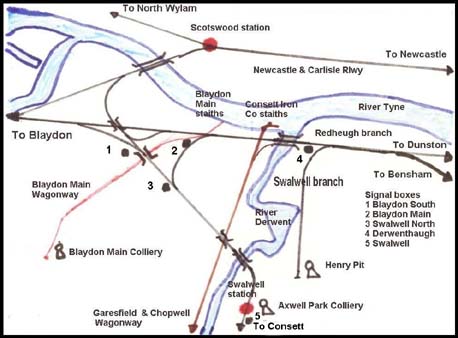
Map showing the railways of Swalwell and Derwenthaugh |
THE MAIN WAY Clockburn Drift closed in 1983, the cokeworks then using coal supplied by rail or road from elsewhere. The cokeworks finally closed in December 1985 and the section of railway from the cokeworks at Winlaton Mill to Derwenthaugh closed then too, bringing to an end railway working on this historic line. The railway trackbed is now in use as a walk and cycle path, running from Derwenthaugh past old Swalwell Bridge and along the north side of the River Derwent's wooded valley to a new footbridge beyond Winlaton Mill when it crosses the river and continues on to join the Derwent Walk at Lockhaugh Viaduct. The cokeworks site has been cleaned up and landscaped by Gateshead Borough Council and now forms part of the Derwent Park leisure area. The railway was mostly single track but with sidings and passing loops. Much of this area is barely recognisable now to those who knew it in the past. Back to top of page |
PASSENGER RAILWAYSThe North Eastern Railway Company (NER), which sought to keep other railway companies out of its territory, were pushed into building a line in the Derwent valley in order to prevent the rival London and North Western Railway from gaining access to Newcastle through its support for the proposed Newcastle and Derwent Valley Railway of 1859. This railway was to have been part of a route from Liverpool to Newcastle via the South Durham and Lancashire Union Railway form Tebay to West Auckland and the Stockton and Darlington's line from there to Hownes Gill near Consett, then running down the Derwent valley and via the still independent Newcastle and Carlisle Railway into Newcastle. The NER challenged this proposal with its own Blaydon and Conside (later Consett) branch scheme for the Derwent valley. The rival proposal was defeated but the North Eastern's own scheme was also defeated due to opposition from supporters of the rival scheme. The Newcastle and Derwent Valley promoters did not give up and submitted a new proposal to Parliament in 1861, this time supported by both the London and North Western and the North British Railway in Edinburgh. The route was to have been from Newcastle over a bridge at Redheugh, through Dunston, Swalwell and up the Derwent valley to Consett and West Auckland and with several branches. Thus, this scheme threatened not only the North Eastern but other railways too. Although the House of Commons passed this new Newcastle and Derwent and Weardale Railway Bill and rejected the NER one, the House of Lords overturned the Commons' decision. The North Eastern then negotiated with its rivals whose plans were abandoned and the North Eastern's own plans were approved in 1862. The NER took over the Newcastle and Carlisle Railway in 1862 and the Stockton and Darlington Railway the following year preventing any further attempted incursions into its territory. 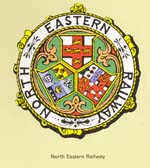 Nothing more was done until 1865 when work commenced on the 11 mile line, which left the main Newcastle to Carlisle line just south of the Tyne near Blaydon, reaching Swalwell after running on a mile long embankment across the flood plain of the Derwent, crossing it by means of a 3 arch stone bridge. The Hexham turnpike road in Swalwell was crossed by another stone bridge (the 'black bridge') just before the station. The line then continued up the Derwent Valley with stations at Rowlands Gill, Lintzford, Ebchester, Shotley Bridge and Blackhill where it made a connection with the 1862 line through Consett and Lanchester to Durham. There was a loop line from the outset connecting with the Redheugh branch (see Derwenthaugh below) facing Blaydon, allowing trains carrying iron ore from the Carlisle direction to reach Consett. Double track was laid for 300 yards south of Scotswood Bridge junction, but most of the rest of the branch was single track initially Back to top of page |
OPENING The railway opened to passenger traffic on 2 December 1867 although Swalwell station itself was not ready and did not open until early in the following year. Although mostly single line, traffic growth made it necessary to double the whole section from north of Swalwell to Rowlands Gill between 1905 and 1908 plus the two bridges at Swalwell. You can see evidence of this doubling on the Swalwell viduct over the Derwent and the remains of the bridge which once crossed the main road, and on the Lockhaugh viaduct near Rowlands Gill. Swalwell also got a second platform, staggered from the first. An additional station was opened in 1909 at High Westwood., serving Chopwell and Hamsterley as well as Westwood. There were various links to the line from the Redheugh branch. In 1897-1898 a curve was built south of Scotswood bridge junction joining the Redheugh branch to the east. The south-east curve, allowing trains from the Consett direction to reach Dunston without the need to reverse at Blaydon, was opened on 24 February 1908.
The railway opened to passenger traffic on 2 December 1867 although Swalwell station itself was not ready and did not open until early in the following year. Although mostly single line, traffic growth made it necessary to double the whole section from north of Swalwell to Rowlands Gill between 1905 and 1908 plus the two bridges at Swalwell. You can see evidence of this doubling on the Swalwell viduct over the Derwent and the remains of the bridge which once crossed the main road, and on the Lockhaugh viaduct near Rowlands Gill. Swalwell also got a second platform, staggered from the first. An additional station was opened in 1909 at High Westwood., serving Chopwell and Hamsterley as well as Westwood. There were various links to the line from the Redheugh branch. In 1897-1898 a curve was built south of Scotswood bridge junction joining the Redheugh branch to the east. The south-east curve, allowing trains from the Consett direction to reach Dunston without the need to reverse at Blaydon, was opened on 24 February 1908.Goods traffic continued to decline as local collieries closed and with the closure of Rowland's Gill station on 11 November 1963 the whole line as far as Blackhill became disused. Note that this was prior to Dr Beeching's programme of closures.The rails were lifted in 1964-5. The Blaydon loop survived for a little longer until 1966. The route became the Derwent Walk from 1972 after the trackbed was cleared of growth and the drainage reinstated, and is now used by walkers, cyclists and horse riders. Part of the embankment carrying the line from Scotswood rail bridge to Swalwell is incorporated in the Gateshead Western Bypass. One of the abutments to the bridge carrying the line over Hexham Road remains and there is a representation of a locomotive affixed to the top advertising the Walk. The Up Platform also remains, almost hidden amongst the undergrowth, near the start of the walk. Up, in railway jargon, means towards the main terminus, and Down, away from the main terminus, thus the Up platform at Swalwell was for trains travelling in the direction of Newcastle, Down, away from Newcastle Back to top of page |
SERVICES Click timetable for LNER timetable 1936 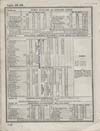 Click timetable for BR timetable 1948 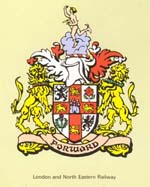 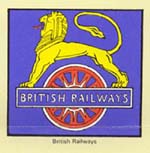 Back to top of page | The 1936 service††runs between Durham and Newcastle via Lanchester and Blackhill, then on through Rowlands Gill and Swalwell to Newcastle. Most trains, however, only run from Blackhill and Swalwell to Newcastle There is a Sunday service. There was also a service from Blackhill and Consett via Annfield Plain and Birtley to Newcastle. By 1948 the route has changed to a circular one, Newcastle to Newcastle, the 1936 Derwent valley service now connecting with the Blackhill, Annfield Plain to Newcastle service and running through Birtley, Annfiield Plain, Consett, Blackhill, Rowlands Gill, Swalwell and Scotswood and thence back to Newcastle. There is only one Sunday train left. The Lanchester valley line has closed for passengers in 1939. Note also that the passenger service from Blackhill to Darlington via Tow Law and Crook shown in the 1936 timetable has been withdrawn (from 1939). Note the short journey times between Newcastle and Swalwell as shown in the timetables, compared to the buses of today.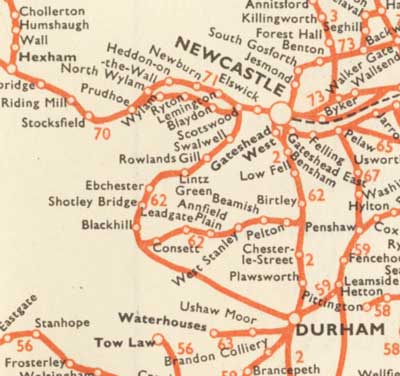
|
SWALWELL STATION The station was approached from Whickham Bank along a short road near Axwell Park colliery. There were eventually two platforms after doubling of the line to Lockhaugh in 1908, and sidings for the pit, a loading dock and the usual station buildings including a station master's house. Sentinel steam railcars were introduced on this very scenic line in London and North Eastern (LNER) days between the wars on the Newcastle - Blackhill - Lanchester - Durham route . A signal box was situated at the west end of the station. Other signal boxes nearby (see map at top of page) were Swalwell North, (see picture under Opening, above), and Blaydon South on the embankment between Swalwell and Blaydon, Blaydon Main between the Derwenthaugh line and the southeast curve from the Dunston direction to Swalwell, and Derwenthaugh just east of the Derwent bridge. There were sidings into the steel works and paper mill from the line just before it crossed Hexham Road, and extensive sidings into Axwell Park Colliery.  Footnote: A former Stationmaster at Swalwell, a Mr William Morris, is buried in the graveyard at St Andrew's Church, Bywell, Northumberland. His gravestone is just inside the entrance on the left. Back to top of page |
DERWENTHAUGH The Blaydon, Gateshead and Hebburn Railway (BG and HR) was formed in 1831 to construct a line linking those towns to carry coal to the staiths at Hebburn, dispensing with the use of keelboats. The company co-operated with the Newcastle and Carlisle Railway (N and CR) on proposals to build a bridge across the Tyne at Redheugh but the smaller company ran out of money after only a mile of line east of Blaydon was completed. The N and CR bought our the BG and HR and completed the line to Derwenthaugh by 1836 and on to Redheugh by 1st March 1837, but the section to Hebburn was never finished. Originally, the bridges across the Team and the Derwent were wooden ones.The N and CR thus originally ran east through Blaydon to Derwenthaugh, where a station served the inhabitants of Swalwell, and on to Redheugh quay (Gateshead), from where passengers crossed to Newcastle by the old 18th century bridge or by ferry, or a connection could be made at Blaydon by road coach. This line briefly had a passenger service. A Swalwell branch was opened on 24 May 1847 running half a mile south from Derwenthaugh.
Back to top of page |
A temporary wooden bridge was built at Scotswood which remained in use until 1868 when a permanent iron girder bridge replacement was opened. This was used until 1982 when the Newcastle to Blaydon via Scotswood section of the Newcastle and Carlisle line closed and all trains (except some coal trains serving Stella North power station) were diverted via the King Edward Bridge and Dunston. Early passenger services from Blaydon as far as Derwenthaugh ran only until the opening of Swalwell station in 1868.
|
MISCELLANEOUSLater Developments East of DerwenthaughAlthough not strictly in the area covered by this history, it is worth noting that additional lines were built east of Derwenthaugh in the early twentieth century to cope with the growing coal traffic. Dunston staiths opened in 1893 and were served by a line from Low Fell via Norwood which also had a connection with the line between Blaydon, Derwenthaugh and Redheugh near the mouth of the river Team. In 1904 a shorter link to Derwenthaugh was opened running from Norwood Junction through Dunston, with a new station, to join the old line at Whickham Junction near the site of Dunston Power Station. Opened early in the twentieth century the siting of the power station meant the diversion of the Derwenthaugh and Redheugh line to the south. Further improvements in the area were completed in 1907 with a link from Norwood Junction to Bensham with a tunnel under the East Coast Main Line. Other links allowed trains from Bensham to reach Low Fell via this tunnel thus avoiding the main line. These links are still in use today. The bottleneck at the High Level bridge was eased in 1906 when the King Edward bridge opened. The old staiths at West Dunston near the Delta works, which predated the new Dunston statihs, eventually closed in the inter-war years and the whole area with its extensive sidings is now covered by the new road linking Dunston with Derwenthaugh, and the by the Metro Centre bus park. The route of the original Newcastle and Carlisle railway through Dunston can be traced behind the Royal Hotel for a short distance and is now a cycle track.The Derwent Walk Express is a 33 metre sculpture located on the bridge abutment of the railway bridge which crossed Hexham Road near the station. It was opened in 1987 by Norman Buchan MP and designed by Andy Frost and is made of marine plywood and steel and painted with gloss and lacquers. Locomotives Although steam railcars operated passenger services for a time in the 1920's and 1930's, locomotives used were usually tank engines of Classes G5 and H1 (later A8). British Railways saw J39's and K1's on the line. The Garesfield wagonway, Swalwell sidings (both Ellis's and the opencast disposal depot) used steam (saddle tank) locos until the 1970's when diesel locos appeared.
Although steam railcars operated passenger services for a time in the 1920's and 1930's, locomotives used were usually tank engines of Classes G5 and H1 (later A8). British Railways saw J39's and K1's on the line. The Garesfield wagonway, Swalwell sidings (both Ellis's and the opencast disposal depot) used steam (saddle tank) locos until the 1970's when diesel locos appeared.
AccidentsIn July 1913 two boys were hurt on the Consett Iron company's railway at Swalwell near Swalwell Bridge. They had boarded a set of wagons being taken from Derwenthaugh to Winlaton Mill and when the wagons reached Swalwell the bottom boards suddenly dropped and the two youths fell out onto the railway. Some of the wagons passed over the foot of James Hope aged 13, which was badly crushed and Thomas Todd, aged 14 had his right foot crushed.. They were carried to their homes by cart and later taken to the Newcastle Infirmary where James Hope's left leg was amputated below the knee and the greater part of Thomas Todd's right leg was removed. In the 1950's a goods train was derailed on the embankment east of Derwenthaugh and the driver and fireman severely injured when the engine fell onto its side and slid onto the embankment.NOTEThe railways of Swalwell and Derwenthaugh are covered in detail in The Railways of Consett and North-West Durham by G Whittle.(David and Charles 1971). See also The Private Railways Of County Durham by Colin E Mountford. (Industrial Railway Society 2004) for detailed coverage of the Main Way and Derwenthaugh area NCB railways.Back to top of page |
| Previous........Next |